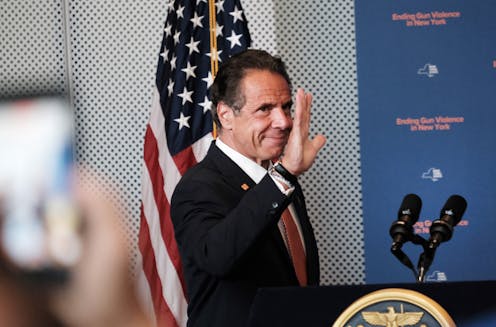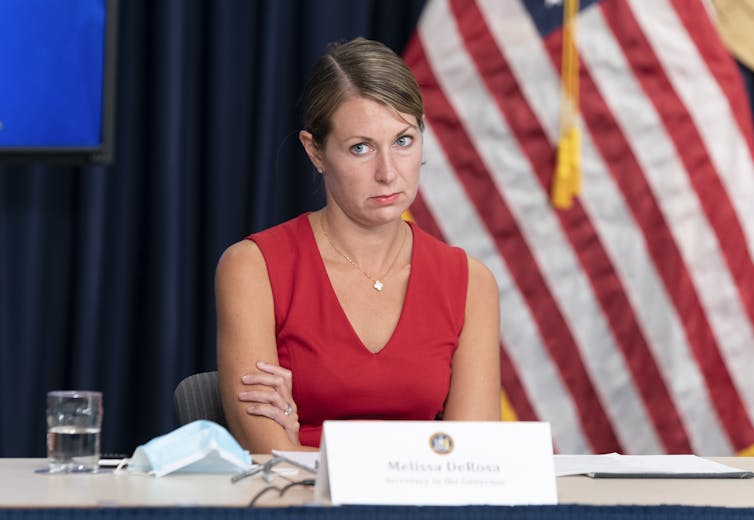Complicity and silence around sexual harassment are common – Cuomo and his protectors were a textboo
Four scholars who study the role witnesses play in helping and protecting harassers say the role played by many in Cuomo’s office fit a pattern of silence, complicity and intimidation.

New York Gov. Andrew Cuomo’s resignation came after more than a week of bad news, starting with a damning report from the state attorney general’s office that detailed his sexual harassment of 11 women, some of whom worked in his office. An executive assistant to Cuomo, Brittany Commisso, filed a criminal complaint against him with the Albany County sheriff’s office. The state Legislature readied impeachment proceedings.
Then, top aide Melissa DeRosa resigned amid a flurry of questions surrounding her role in protecting Cuomo. Attorney Roberta Kaplan also resigned from the #MeToo advocacy organization Time’s Up after the attorney general’s report revealed that she helped draft a letter that denied Cuomo’s wrongdoing.
As news emerged about the silence from Cuomo’s staff, who had long protected him, and his victims who feared blowback, our thoughts turned immediately to our research on harassers.
“See No Evil, Hear No Evil, Speak No Evil” is the title of our new article for the Journal of Applied Psychology, which describes the role witnesses play in helping and protecting harassers. Evidence suggests that, rather than helping victims, witnesses often protect the harasser.
The report on Cuomo’s sexual harassment is replete with examples that showcase how members of Cuomo’s top staff, known collectively as the “Executive Chamber,” silenced victims. One victim explained in the report: “I was terrified that if I shared what was going on that it would somehow get around … and if senior aides Stephanie Benton or Melissa DeRosa heard that, I was going to lose my job.”
Although #MeToo gave voice to millions of women to speak up about sexual harassment, it remains rare for victims to report sexual harassment to employers. They are afraid of blowback. They think management won’t believe them. They fear being blamed or shamed. And these fears are warranted.
Silent complicity
Research shows that reporting mechanisms rarely work and often backfire.
For example, employees who speak up about workplace harassment frequently face retaliation, both personal and professional. This is evident in multiple victim accounts in the Cuomo investigation.
One victim was quoted in the report saying that “she did not feel she could safely report or rebuff the conduct because, based on her experience and discussion with others … it’s kind of known that the Governor gives the seal of approval who gets promoted and who doesn’t.”
But what about bystanders? Colleagues? Leaders? Why don’t they speak up when they see sexual harassment?
Part of the problem, we have found, lies with social networks – the webs of interconnections among victims, perpetrators, co-workers and managers. The way these networks are configured encourages members to be silent, silence others and not hear victims who voice concerns about sexual harassment.
One of Cuomo’s 11 alleged victims, a state trooper, described a conversation she had with Cuomo while driving him to an event. The governor questioned her clothing choices, asking why she wasn’t wearing a dress. After the conversation, the victim’s state police superior, who was in the car during the interaction, messaged her, saying that the conversation “stays in the truck.”

‘Textbook example’
Why do people protect harassers? A number of factors are at play.
First, a harasser can establish a central status by having many strong ties to others in the network. Strong relationships within a tie require an investment of time and resources on both sides, and in turn, they yield loyalty and reciprocity. So network members close to the harasser are more likely to stay silent about his misdeeds, and to silence or manipulate those who speak up into questioning their sanity.
Also, when the harasser is the sole link between disconnected members of the network, he can isolate victims, control information and conceal wrongdoing. The result of all this: Victims, witnesses and would-be supporters stay silent.
In the case of Cuomo, he had many loyal ties. The attorney general’s report states that the Executive Chamber had “an intense and overriding focus on secrecy and loyalty that meant that any and all perceived acts of ‘disloyalty,’ including criticism of the Governor [Cuomo] or his senior staff, would be met with attacks of a personal and professional nature.”
The second reason people protect male sexual harassers lies in how certain network beliefs prize men and masculinity. These beliefs normalize male dominance over women, encouraging support for those who enact displays of masculine superiority.
When these beliefs pervade a social network, and central men sexually harass women, network members stay silent. They also rally to defend and protect harassers by silencing and not hearing those who speak up.
Because women are devalued in these networks, powerful witnesses have little motive to hear sexual harassment complaints or take action to support female victims. The investigation into Cuomo’s conduct concluded: “This culture of fear, intimidation, and retribution co-existed in the Executive Chamber with one that accepted and normalized everyday flirtations and gender-based comments by the Governor.”
Finally, mythologies about sexual harassment are frequently found in social networks such as the one that surrounded Cuomo. These common myths deny that sexual harassment has happened, often by questioning women’s complaints – for example, suggesting that false allegations are common. Or they downplay the gravity of these offenses.
When harassment becomes undeniable, myths lead network members to move on to justify it: absolving harassers of responsibility or blaming victims – asking what women did to invite sexual advances.
Myths such as these silence network members because speaking up is likely to be futile or even dangerous. Throughout the report, senior staff members in Cuomo’s office denied wrongdoing by Cuomo. One victim, Ana Liss, testified that Cuomo had held her hand, kissed her cheek and been flirtatious. She did not want to report it because “the environment in the Executive Chamber deterred her … she was fully expecting the Governor’s team would deny, deny, deny, character assassinate.”
It is rare that scholarly research and current events so perfectly reflect each other. But the Cuomo case is – no metaphor here – a textbook example of a network of complicity and silence around sexual harassment.
[The Conversation’s Politics + Society editors pick need-to-know stories. Sign up for Politics Weekly._]
sandy.hershcovis@haskayne.ucalgary.ca receives funding from the Social Sciences and Humanities Research Council of Canada.
Ivana Vranjes, Jennifer L. Berdahl, and Lilia M. Cortina do not work for, consult, own shares in or receive funding from any company or organization that would benefit from this article, and have disclosed no relevant affiliations beyond their academic appointment.
Read These Next
Epstein’s victims deserve more attention than his ‘client list’
Powerful men connected to Jeffrey Epstein are named, dissected and speculated about. The survivors,…
Best way for employers to support employees with chronic mental illness is by offering flexibility
Employers that don’t support employees with mental illness risk missing out on the talents and skills…
From civil disobedience to networked whistleblowing: What national security truth-tellers reveal in
Whistleblowers’ stories show how accountability is shifting from formal legal institutions to solidarity…





